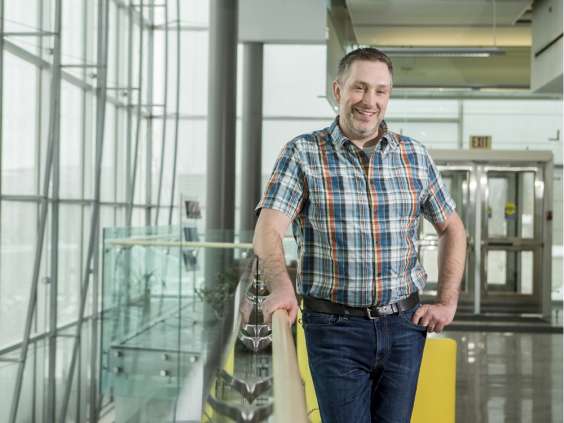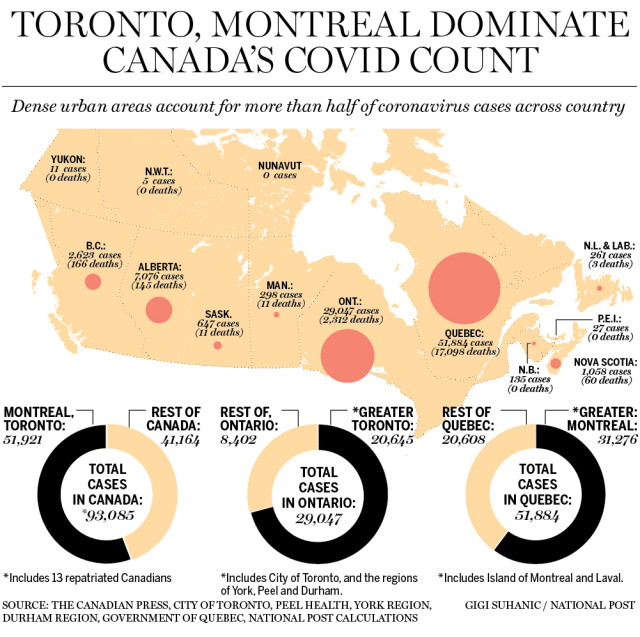“It’s been going on since February, so you need to sleep sometime, right? At least, I can’t just go on and on and on. We work sometimes 15, 16 hours a day. I’m not going to lie and say that’s every day, because that’s just not sustainable, at least not for me, anyway. Most of the people are working six, seven days a week. And it’s tiring; I’m not gonna lie about that either. It wears on you after a while, because it’s not just been, like, six weeks of working hard now. It’s been (he ticks off the months under his breath — February, March, April, May) four months, right?”
Dr. Darryl Falzarano is a vaccine hunter. Until the COVID-19 pandemic struck, his lab was focused on developing vaccines for camels against MERS. Today, Falzarano is leading a 12-member team at the University of Saskatchewan’s Vaccine and Infectious Disease Organization-International Vaccine Centre (VIDO-InterVAC), which received nearly $ 1 million in funding to expedite work on a COVID-19 vaccine, part of a $ 26.7 million research package from the federal government.
Most of the people are working six, seven days a week. And it’s tiring
Recently, Falzarano’s lab reported in a university release that their experimental vaccine induced a strong immune response in ferrets, which, like humans and cats, but unlike dogs, pigs, chickens and ducks, are highly susceptible to severe acute respiratory syndrome-coronavirus 2, or SARS-CoV-2, the virus rattling the planet.
After receiving two doses of the vaccine, the ferrets were exposed to the virus. “One of the things we looked for after we vaccinated the animals was, do they have neutralizing antibodies — do they have antibodies that block the virus from infecting cells? And they do,” Falzarano said.

Ideally a vaccine is going to do two things, he explained: stop the virus from replicating in the lungs and making people severely ill, and stop people from shedding the virus and sharing it with other people.
They’ve now moved into hamsters. The plan is to move into “first-in-human” studies in the fall, with a human-grade vaccine.
No one, Falzarano said, has ever developed a vaccine against coronaviruses in humans, which is why there’s “no totally clear pathway forward as to what that really should be.” It also explains why there are, as of this writing, 132 other vaccines in development, including 10 now being injected into humans. Dalhousie University researchers are awaiting research ethics board approval to lead the first Canadian trials in humans of a vaccine developed by Chinese manufacturer Casino Biologics. The University of Alberta, University of Manitoba, Western University and the University of Waterloo are among other Canadian groups in the feverish sprint to a vaccine.
It normally takes 10 years to develop a vaccine. Everyone is trying to do this in about one. Even then, corners aren’t being cut, Falzarano said. Steps are being overlapped, but safety isn’t being compromised, he said. The same regulatory data is still required; it’s just being done in an accelerated way. “A vaccine that doesn’t work, maybe that’s not the end of the world. A vaccine that’s not safe, that would be a huge problem. I think everyone is acutely aware of that risk.”

Vaccinating ourselves out of the COVID-19 mess may be our best hope at ending lockdowns permanently and substantially reducing deaths. “A lot of planning around returning to a fully open society rests on a lot of people getting this future vaccine,” said Maya Goldenberg, an associate professor of philosophy at the University of Guelph.
But as research teams around the world work at breakneck speed to deliver one, how accepting will we be? It depends on how much we trust political leaders and scientific bodies, said Goldenberg. “We’ll trust a vaccine to the extent that we trust the system that brought us the vaccine.”
There are already drumbeats of hesitancy. A survey by researchers in Carleton University’s School of Journalism and Communication, in partnership with Abacus Data, found that while a strong majority (73 per cent) of 2,000 Canadians surveyed would “definitely” or “probably” accept a COVID-19 vaccine, 10 per cent said they would definitely, or not likely, get vaccinated, and 17 per cent were unsure.
Anti-vaccination forces are already marshalling and “seeding outlandish narratives,” Nature reports, including, that COVID-19 vaccines will be used to implant microchips into people. In May, a YouTube video claiming vaccines would “kill millions” received more than eight million views before it was deleted, Nature reported.
Goldenberg and others say health leaders need to start talking up vaccines, now. The newness of the vaccine, and a “break the glass” mentality in pushing them out could make people wary, said Dr. Paul Offit, professor of paediatrics at Children’s Hospital of Philadelphia and co-inventor of a vaccine against a rotavirus, the most common cause of severe diarrhea in babies and children worldwide. No amount of data will ever convince anti-vaccine conspiracy theorists, but a reasonable level of skepticism is healthy. “I think we have, generally, the confidence of parents in this country. But as is true for anything you put into your body, you should be skeptic
al — I’m going to be skeptical about these vaccines when they come out,” Offit said this week in a live-streamed interview with JAMA editor-in-chief Dr. Howard Bauchner. “I want to see the data. Everybody should want to see the data. I think there’s a lot at stake here.”
“We better make sure that before we inoculate millions of people, tens of millions, many of whom are going to be healthy, young people who are unlikely to die from this virus that we make sure we hold it to the highest standard of safety and efficacy before we put it out there.”
Goldenberg, an expert in vaccine hesitancy whose research, according to her bio, explores the “fundamental epistemic question, ‘How do we know what to believe?” said the race for a vaccine has become politicized, a “geopolitical fight between China and the USA” to be first. “There’s a global economic strength tied to being the first to have this vaccine,” she said.
“This is also going to be a big and difficult decision for people to make and everyone needs time to process it and everyone needs really good information.”
The public needs to be updated on the trials — which ones are going well, which ones aren’t. “We know already that there is a lot of spin,” she said, and science by opaque press release. Andrew Pollard, head of the Oxford Vaccine Group, said in a recent press statement that their human studies are “progressing very well.” Boston-based biotech firm Moderna was accused of overhyping results when it told CNN its vaccine produced protective antibodies in a small number of healthy volunteers during a safety trial. None of the data have been published in peer-reviewed journals.
Under “Operation Warp Speed,” U.S. President Donald Trump has set a target of having 300 million vaccine doses available by the end of 2020. For scientists and doctors and, arguably, the public, the idea of pushing any vaccine out into the population with “warp speed” doesn’t inspire comfort, Dr. Brit Trogen, of NYU Langone and colleagues write in a new paper published by JAMA. In 1976, a U.S. campaign to vaccinate “every man, woman and child” against a feared swine flu pandemic that never came failed miserably, they wrote. One manufacturer produced the wrong strain. The shots were blamed for a blip in Guillian-Barré syndrome, a rare neurological disorder. Children developed high fevers, “or did not mount an immune response at all.” The fiasco damaged public trust and helped buoy the anti-vaccine movement.
Good science requires rigour, discipline and deliberate caution
“Good science requires rigour, discipline and deliberate caution,” the NYU authors wrote, and there will be only one shot at winning public acceptance of a COVID-19 vaccine.
Falzarano, at U of Saskatchewan, thinks the one-year mark is bullish, but possible. However, “I don’t think you have 100 million doses by then, and even if you had 100 million, that’s nothing.” Deciding who gets vaccinated first will be complicated, he said: “The country that has the most cases? Your country, regardless of how many cases you have?” Frontline workers first? The most susceptible? The lottery scene in the movie, Contagion? “I think that part becomes problematic,” Falzarano said.
The other concern: If infection rates decline, and transmission slows, it will become harder to test vaccines in critical Phase III trials. “If the proof is in the pudding, the pudding is the Phase III trial,” said Offit. The trials typically involve tens of thousands of people. Half randomly receive the vaccine, the other half placebo, and then everyone is sent back out into the real world to see, does the vaccine protect against natural infection? “That process normally takes months to years, during which SARS-2 will infect and possibly kill millions,” NYU bioethicist Arthur Caplan and rubella vaccine developer Stanley Plotkin recently wrote in the journal Vaccine.

One option is challenge studies, where healthy human volunteers are given a test vaccine (or placebo) and then deliberately infected with the pandemic virus. Caplan and Plotkin said researchers could take advantage of the low rate of death in 18- to 29-year-olds (0.03 per cent, based on studies from China). Already, more than 28,000 people from 102 countries have expressed a willingness to be human challenge test subjects.
Challenges studies have a long history. They’re very controlled. “They’re usually done in a proper environment, where you are isolating the volunteers so that you are protecting from further infection and spread in the community. They’re watched and monitored very carefully for any kind of adverse event,” said Claudia Emerson, a philosopher at McMaster University and member of a World Health Organization expert working group that has developed guidelines for the ethical acceptability of challenge trials. Still, while the young and healthy are thought to be at low risk, “we still can’t predict, if we were to bring in 50 young healthy volunteers, how many of them could go on to develop a severe case of the disease,” Emerson said. There is no proven treatment for COVID-19.
Deliberately infecting humans with a pathogen of interest is normally “abhorrent,” Caplan and Plotkin acknowledged, “but asking volunteers to take risks without pressure or coercion is not exploitation but benefitting from altruism,” and extraordinary times, they said, sometimes require unconventional approaches.
“As Shakespeare put it, Desperate diseases by desperate measures are relieved.”
National Post
• Email: skirkey@postmedia.com Twitter: sharon_kirkey


